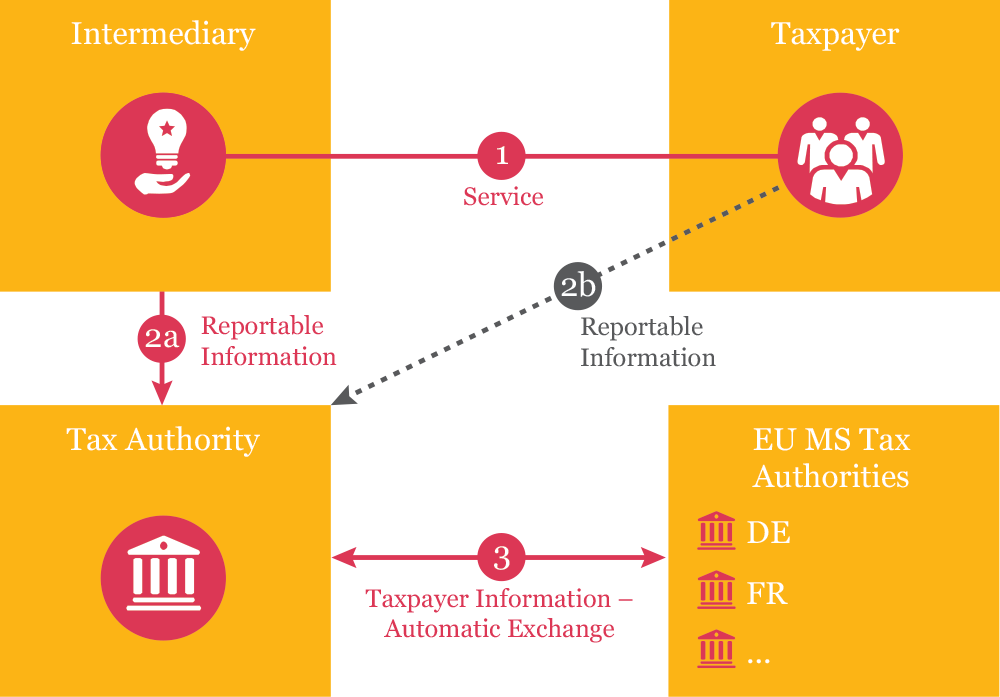{{item.title}}
{{item.text}}

{{item.text}}
The Commissioner for Revenue (“CfR”) has published the Guidelines on the Mandatory Automatic Exchange of Information in relation to Cross-Border Arrangements (the “Guidelines”). The Guidelines are to be read in conjunction with the Cooperation with Other Jurisdictions on Tax Matters Regulations (Subsidiary Legislation 123.127) including any amendments thereto, transposing the provisions of Council Directive 2018/822 (“DAC6”) including any amendments thereto, into Maltese legislation.
Access Guidelines
DAC6 requires the identification and reporting of cross-border arrangements involving at least one EU Member State and which feature one or more ‘hallmarks’ which are considered to be indicative of potentially aggressive tax arrangements.
The EU Parliament has recently voted in favour of an optional deferral (i.e. the deferral is at the option of each Member State) of the reporting deadlines set out in DAC6 (Council Directive (EU) 2018/822 of 25 May 2018 amending Directive 2011/16/EU as regards mandatory automatic exchange of information in the field of taxation in relation to reportable cross-border arrangements).
This vote cleared the last procedural hurdle before the amended Directive was formally adopted and published in the Official Journal of the European Union on 24 June 2020.
On 2 July 2020, the Maltese Commissioner for Revenue issued a notice confirming that the first reporting deadlines will be deferred by six months. In terms of the amending legal notice (LN 315 of 2020) which was issued on 31 July 2020, the applicable DAC6 reporting deadlines were deferred as follows:
We will be glad to assist you with the process of analysing the impact of DAC6 on your organisation.
DAC6 sets out to strengthen transparency in the tax ecosystem. The Directive requires reporting very detailed information on a broad range of cross-border tax arrangements, down to the level of individual names involved. DAC6 compliance is a continuous marathon for taxpayers and it's part of the "new normal" of the tax ecosystem.
Where do you stand in this marathon? Are you a front runner? Or are you still at the starting line?
Legal Notice 342 of 2019 which was published on 17 December 2019 introduces the rules which transpose the provisions of the sixth update to Council Directive 2011/16/EU on administrative cooperation in the field of taxation into Maltese law (DAC 6 or the Directive).
The new rules reflect the provisions of the Directive and impose mandatory disclosure by certain intermediaries (and taxpayers, in specified situations) of defined cross-border arrangements.
{{item.text}}

{{item.text}}
The EU is introducing an additional level of tax transparency in order to detect potentially aggressive tax arrangements.
The amendment to Directive 2011/16/EU on mandatory automatic exchange of information in the field of taxation in relation to reportable cross-border arrangements (DAC6 for short) has far-reaching consequences for tax advisors, service providers and taxpayers – including organisations and individuals in Malta.
DAC6 imposes mandatory disclosure requirements with respect to certain arrangements with an EU cross-border element where the arrangements fall within certain "hallmarks" mentioned in the directive and in certain instances where the main or expected benefit of the arrangement is a tax advantage. A mandatory automatic exchange of information on such reportable cross-border schemes is being introduced via the Common Communication Network (CCN) which will be set-up by the EU.
Although the directive is not effective until 1 July 2020, taxpayers and intermediaries need to monitor and collect data with respect to any cross-border arrangements which date back to 25 June 2018. Therefore the time to act is now.
These new EU rules can potentially impact any individual or entity involved in designing, marketing, organising, making available for implementation or managing the implementation of potentially aggressive tax-planning arrangements (as defined in the directive) with an EU cross-border element as well as those who provide assistance or advice. Taxpayers, including individuals, legal persons (i.e. companies and foundations) and legal arrangements (i.e. trusts) can potentially also be affected.
The following are a few examples of persons who may be affected by the new EU rules when providing the aforesaid services:
The main purpose of DAC6 is to strengthen tax transparency and the fight against aggressive tax planning. It broadly reflects the elements of action 12 of the BEPS project on the mandatory disclosure of potentially aggressive tax-planning arrangements as well as the OECD model regarding mandatory reporting of CRS avoidance schemes and opaque offshore arrangements.
Mandatory reporting by intermediaries (or taxpayers) and the automatic exchange of information by the tax authorities of EU member states via the Common Communication Network (CCN) for a wide range of cross-border arrangements in relation to individuals and entities.
DAC6 imposes mandatory disclosure requirements for arrangements with an EU cross-border element where the arrangements fall within certain "hallmarks" mentioned in the directive and in certain instances where the main or expected benefit of the arrangement is a tax advantage. There will be a mandatory automatic exchange of information on such reportable cross-border schemes via the Common Communication Network (CCN) which is being set up by the EU.
The potentially aggressive tax planning arrangements with a cross-border element need to be reported by the intermediaries to the tax authorities in the country in which they are resident. The EU member states will then share the information with all other member states via the Common Communication Network (CCN) on a quarterly basis.
If the taxpayer develops the arrangement in-house, or is advised by a non-EU adviser, or if legal professional privilege applies, the taxpayer must notify the tax authorities directly.
Penalties will be imposed on intermediaries (or taxpayers) that do not comply with the transparency measures. EU member states must implement effective, proportionate and dissuasive penalties.
Our team combines experts in tax, people, processes, data and technology. By bringing together these different skill sets, we can help you understand DAC6 and the broader tax policy context, and implement effective controls and processes to ensure that all reportable cross-border arrangements are proactively identified and managed.
Impact assessment: We can analyse your current and planned activities so as to help you understand the possible impact the directive may have on your reporting obligations.
Governance framework: We can help you develop a comprehensively documented governance framework to define roles and responsibilities with respect to the reporting obligations and to identify and manage risks.
Data management: We can support you in the effective and efficient collation, analysis and storage of reportable data.
Reporting: Using technology, we can assist you to fulfil multiple reporting requirements using the same data set and reporting mechanism in the required format, and with preparing the necessary paperwork.





